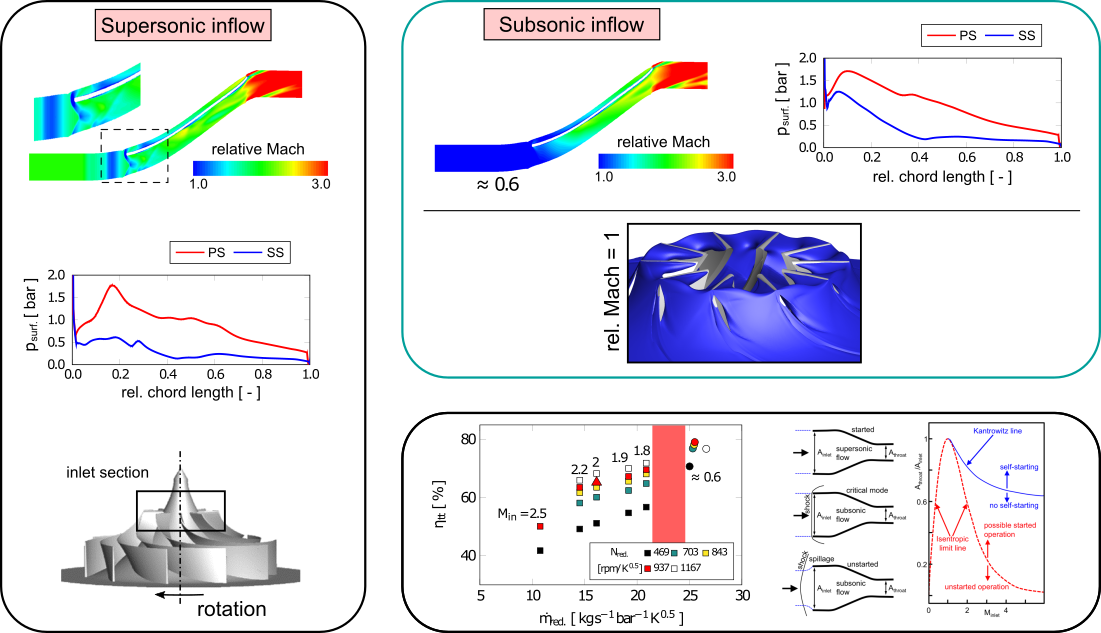Global Fellowship
ROTRANS: Rotating Devices Performing Subsonic Supersonic Flow Transitions
WHY IS IT IMPORTANT...
Occurring shock systems in the supersonic flows, e.g. at the leading edge of the turbomachine rotor, reduce the machine efficiency drastically and threaten the responsible use of energy. The started project aims at developing a new understanding of the shock establishment and high-frequency response within the rotor. It is divided into an outgoing phase at Purdue University and a return phase at TU Berlin. During the outgoing phase, a numerical analysis of the observed phenomenon will be conducted to develop a reduced model based on 3D characteristics. This model will thoroughly be validated by advanced experimental measurements. Back at the TU Berlin, the final applicability of the reduced model and the functionality of the novel concept will be assessed by a design optimization of a turbine and a compressor geometry.

What is it about...
RESEARCH SCOPE
Occurring shock systems in the supersonic flows, e.g. at the leading edge of the turbomachine rotor, reduce the machine efficiency drastically and threaten the responsible use of energy. The started project aims at developing a new understanding of the shock establishment and high-frequency response within the rotor. It is divided into an outgoing phase at Purdue University and a return phase at TU Berlin. During the outgoing phase, a numerical analysis of the observed phenomenon will be conducted to develop a reduced model based on 3D characteristics. This model will thoroughly be validated by advanced experimental measurements. Back at the TU Berlin, the final applicability of the reduced model and the functionality of the novel concept will be assessed by a design optimization of a turbine and a compressor geometry.
HOW WE DO IT...
WORKPLAN
CFD SIMULATIONS
Lorem ipsum dolor sit amet, consectetur adipiscing elit. Cur tantas regiones barbarorum pedibus obiit, tot maria transmisit.REDUCED MODELING
Lorem ipsum dolor sit amet, consectetur adipiscing elit. Cur tantas regiones barbarorum pedibus obiit, tot maria transmisit.EXPERIMENTS
Lorem ipsum dolor sit amet, consectetur adipiscing elit. Cur tantas regiones barbarorum pedibus obiit, tot maria transmisit.OPTIMIZATION
Lorem ipsum dolor sit amet, consectetur adipiscing elit. Cur tantas regiones barbarorum pedibus obiit, tot maria transmisit.PROGRESS...
PROJECT RESULTS
Occurring shock systems in the supersonic flows, e.g. at the leading edge of the turbomachine rotor, reduce the machine efficiency drastically and threaten the responsible use of energy. The started project aims at developing a new understanding of the shock establishment and high-frequency response within the rotor. It is divided into an outgoing phase at Purdue University and a return phase at TU Berlin. During the outgoing phase, a numerical analysis of the observed phenomenon will be conducted to develop a reduced model based on 3D characteristics. This model will thoroughly be validated by advanced experimental measurements. Back at the TU Berlin, the final applicability of the reduced model and the functionality of the novel concept will be assessed by a design optimization of a turbine and a compressor geometry.
PUBLICATIONS...
PROJECT JOURNAL & CONFERENCE PAPERS